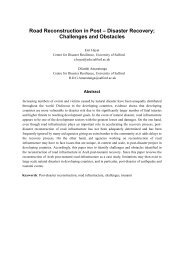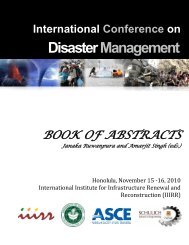Seismic Survey and Condition Assessment of School Buildings ...
Seismic Survey and Condition Assessment of School Buildings ...
Seismic Survey and Condition Assessment of School Buildings ...
Create successful ePaper yourself
Turn your PDF publications into a flip-book with our unique Google optimized e-Paper software.
<strong>Seismic</strong> <strong>Survey</strong> <strong>and</strong> <strong>Condition</strong> <strong>Assessment</strong> <strong>of</strong> <strong>School</strong><br />
<strong>Buildings</strong><br />
(Case Study Done in the Eastern Province, Sri Lanka)<br />
H.A.D.S.Buddika,<br />
Department <strong>of</strong> Civil Engineering, University <strong>of</strong> Peradeniya, Sri Lanka<br />
samithbuddika@gmail.com<br />
Ranjith Dissanayke<br />
Department <strong>of</strong> Civil Engineering, University <strong>of</strong> Peradeniya, Sri Lanka<br />
ranjith@civil.pdn.ac.lk<br />
Abstract<br />
Major economic consequences <strong>and</strong> losses <strong>of</strong> lives are evident in recent Tsunami tidal waves that<br />
ravaged several countries in the Indian Ocean Rim on December 26, 2004. Although considered a<br />
moderate seismic region, in Sri Lanka, the 2004 Tsunami claimed over 38,000 lives <strong>and</strong> investment<br />
need for post reconstruction strategy amounted to $2,089Mn. <strong>School</strong>s are playing vital role in every<br />
community. Disaster safe schools must be recognized as a basic human right. This statement is easy to<br />
make but difficult to accomplish Therefore, it is the high time to investigate the disaster vulnerability<br />
<strong>of</strong> important structures such as schools to withst<strong>and</strong> the future natural disasters.<br />
This paper summarizes the outcomes <strong>of</strong> seismic vulnerability assessment procedure carried out on<br />
schools in Eastern Province, Sri Lanka. The typical structural deficiencies found during the<br />
investigation are summarized in this paper. The main aim <strong>of</strong> this work is to identify the existing<br />
seismic vulnerable conditions in the school buildings, in order to establish detail investigation<br />
procedure to minimize the damages to withst<strong>and</strong> future disasters.<br />
Keywords: future disasters, rapid Visual Screening, structural deficiencies, vulnerability <strong>Assessment</strong>
1. Introduction<br />
<strong>School</strong>s are playing vital role in every community. The public school network in Sri Lanka is vast,<br />
with about 4.2 million children enrolled in over 9,790 public schools around the country. These<br />
schools contain a teaching force about 2 lacks [1] .<strong>Seismic</strong>ally safe schools must be recognized as a<br />
basic human right. This statement is easy to make but difficult to accomplish. Government <strong>of</strong>ficials<br />
<strong>and</strong> community stakeholders are accountable <strong>and</strong> morally responsible for acknowledging the necessity<br />
to improve seismic safety in schools <strong>and</strong> to act upon that knowledge. Forging alliances between the<br />
many groups involved in school administration <strong>and</strong> government can be an initial step towards<br />
significant safety improvements. These alliances can provide a multi-disciplinary approach to<br />
problem-solving, <strong>and</strong> bring added capacity <strong>and</strong> energy to accomplishing the daunting tasks <strong>of</strong> seismic<br />
assessment <strong>and</strong> reconstruction [1].<br />
Even though considered as a non-seismic region, Sri Lanka would expect maximum ground<br />
acceleration <strong>of</strong> 0.3g [2]. Recent catastrophic natural hazard, 2004 Tsunami claimed over 38,000 lives<br />
<strong>and</strong> investment need for post reconstruction strategy amounted to more than $2 billion in Sri Lanka.<br />
Therefore, it is the high time to prepare against future disasters because repair <strong>and</strong> reconstruction <strong>of</strong><br />
school buildings are difficult <strong>and</strong> expensive after earthquake, when government resources are restrain.<br />
Figure1: Tsunami memorial in school<br />
Figure 2: Memories after period <strong>of</strong> one year<br />
Those responsible for school safety must underst<strong>and</strong> <strong>and</strong> manage these risks, particularly those risks<br />
that threaten the lives <strong>of</strong> students, teachers, <strong>and</strong> staff. Earthquake risk is the product <strong>of</strong> hazard<br />
exposure <strong>and</strong> building vulnerability, as shown in the following equation: [5]<br />
RISK = HAZARD x VULNERABILITY x EXPOSURE
2. <strong>Seismic</strong> risk assessment Method<br />
The various methods for the assessment <strong>of</strong> the vulnerability <strong>of</strong> buildings differ in expenditure <strong>and</strong><br />
precision. The type <strong>of</strong> method chosen depends on the objective <strong>of</strong> the assessment but also on the<br />
availability <strong>of</strong> data <strong>and</strong> technology. The table 01 shows the Methods for the assessment <strong>of</strong> the<br />
vulnerability <strong>of</strong> buildings [7].<br />
Table 01: Methods for the assessment <strong>of</strong> the vulnerability <strong>of</strong> buildings<br />
Total 30 schools (more than 400 buildings) were instigated with rapid visual screening procedure.<br />
Since, Sri Lanka does not have local guidelines to do the visual screening; a novel screening format<br />
was developed in order to cope with local conditions. This paper will highlight the structural<br />
deviancies identified in the survey only. However, important details such as number <strong>of</strong> students, work<br />
force <strong>and</strong> previous disaster were recorded for further research purposes.<br />
3. Results <strong>and</strong> Discussion<br />
The type <strong>of</strong> building identified during the investigation procedure can be categorized as, concrete<br />
frame with unreinforced masonry infill walls, unreinforced masonry structures <strong>and</strong> etc. It is very<br />
interested to notice that, majority <strong>of</strong> the buildings (about 70%) are comprised with unreinforced<br />
masonry buildings with compared to reinforced concrete frame buildings that represent 29% <strong>of</strong> the<br />
total buildings. The figure 3 illustrates the information’s found during the survey in a format <strong>of</strong> pie<br />
chart. Other than that, most <strong>of</strong> the school buildings were constructed at the 10-20 years ago which is<br />
now in bad conditions. Even though some buildings are relatively new it is required to further stress<br />
that, these school buildings are vulnerable due to lack <strong>of</strong> maintenance; therefore some <strong>of</strong> them have<br />
changed its use to administrative <strong>of</strong>fice only. The typical buildings found during the visual<br />
observation procedure are shown in figures 4.
Figure 3: Classification <strong>of</strong> buildings according to type <strong>of</strong> construction<br />
Figure 4: Typical single storey <strong>and</strong> multistory buildings in school<br />
The deficiencies <strong>of</strong> the school buildings can be summarized under several topics. Firstly, some old<br />
school buildings are <strong>of</strong> only load bearing masonry without any seismic safety provisions. Therefore,<br />
the gravity load transfer is only through walls. Hence in the case <strong>of</strong> earthquake, the lateral load will be<br />
transferred through the elements which are masonry (fig.3). As a result <strong>of</strong> that, the wall could be<br />
cracked from the openings <strong>and</strong> may lead to collapse <strong>of</strong> building. In addition to that, in the reinforced<br />
concrete (RC) structures the efficiency <strong>of</strong> the RC system depends on its beam-column foundation<br />
interaction to transfer the lateral loads from earthquake. None <strong>of</strong> the school building has been design<br />
in order to with st<strong>and</strong> lateral loads. It is necessary to further stress that, the joint detailing requires<br />
special confinement to accomplished ductile mode <strong>of</strong> failure. The detailing have to be in such a way<br />
that, failure has to be occurring in the beam not in the column. On the other word, strong column-weal<br />
beam concept. The existing cracks in the main load bearing elements such as columns (fig.4) can be<br />
vulnerable during earthquakes. Since, the structure is already crack its load bearing capacity<br />
drastically goes down <strong>and</strong> building can fail due to its limited lateral load bearing capacity.
Figure 3: Brick columns in the building<br />
Figure 4: Failure <strong>of</strong> corner columns<br />
The irregular building configurations were observed in many <strong>of</strong> buildings. The “L” <strong>of</strong> the building in<br />
plan was the popular configuration in many <strong>of</strong> buildings. Due to its irregularity in plane it can<br />
undergo tensional mode <strong>of</strong> vibration during the earthquakes. Other than that, presences <strong>of</strong> short<br />
columns were observed at the most <strong>of</strong> the school buildings. In case <strong>of</strong> earthquake the short columns<br />
are liable to fail due to high stress concentrations (figure 5).<br />
Figure 5: Short columns in the buildings<br />
Despite <strong>of</strong> that, the foundation condition is one <strong>of</strong> important parameter to govern the seismic safety <strong>of</strong><br />
buildings. As the evidence found during the investigation procedure it can be conclude that the most<br />
<strong>of</strong> the buildings possess bad foundation conditions due to scouring. Since the ground condition is<br />
almost a s<strong>and</strong>y soil, the conditions can be vulnerable during the earthquake action.
Figure 6: Foundation conditions observed in the survey<br />
In addition to the main structural deficiencies, control <strong>of</strong> fire is very much important after an<br />
earthquake happen. As the evidence from the seismic survey it can be concluded that many <strong>of</strong> the<br />
buildings are with bad electric installation systems. Therefore, fire can be initiate <strong>and</strong> spread after<br />
disasters. The following figures show the typical wiring installation system in a school.<br />
Figure 7: Typical electric installation systems found during the survey<br />
The results obtain during the visual observation procedure show that a large number <strong>of</strong> school<br />
buildings are moderately or highly vulnerable to earthquake loading. The main defective identified<br />
during the study is poor structural conditions such as cracks, reinforced exposures, etc that consist <strong>of</strong><br />
68 % <strong>of</strong> total buildings. Other than that, 44 % <strong>of</strong> the building posses the week foundation conditions<br />
such as scouring <strong>and</strong> permanent damages due to various actives. In addition to that, the other<br />
structural defect is the short column problem which not only appears in old constructions but also in<br />
new buildings constructed with no technical assistance consists <strong>of</strong> 23 % <strong>of</strong> total buildings. S<strong>of</strong>t storey<br />
in buildings, structural irregularities were observed as other leading problems in the structural system<br />
<strong>of</strong> school buildings. The results <strong>of</strong> the structural classification with respect to type <strong>of</strong> defects are<br />
summarized in the figure 8.
Figure 8: Structural deficiencies as a percentage <strong>of</strong> totals<br />
4. Conclusion<br />
In this study total 30 school buildings (more than 400 buildings) were investigated with visual<br />
observation procedure. This methodology shown to be effective capturing the basic features <strong>of</strong> the<br />
school buildings for a rapid <strong>and</strong> economical assessment <strong>of</strong> the seismic vulnerability. From the basic<br />
structural types identified, the unreinforced masonry structures are dominant. Others consist <strong>of</strong><br />
reinforced concrete structures <strong>and</strong> wooden structures. It is very interested to notice that, not only old<br />
buildings but also newly constructed buildings posse’s structural deficiencies. Accordingly, it can be<br />
concluded that, majority <strong>of</strong> school buildings are posse’s structural deficiencies against seismic loading<br />
conditions. Therefore, it is recommended that, the school buildings need more attention prior to its<br />
construction as well as during maintain in order to overcome such vulnerable conditions.<br />
5. Reference<br />
http://studentlanka.com/alevel/government-schools/<br />
Pr<strong>of</strong> Abayakoon S.B.S., Journal <strong>of</strong> the geological society <strong>of</strong> Sri Lanka, vol 6 (1995/96) 65-72, Sri<br />
Lanka.<br />
http://www.preventionweb.net/files/3285_UNISDRAsiaPacificRegional2.pdf<br />
http://eusoils.jrc.ec.europa.eu/esdb_archive/eudasm/asia/lists/clk.htm<br />
Rapid Visual Screening <strong>of</strong> <strong>Buildings</strong> for Potential <strong>Seismic</strong> Hazards, FEMA 154, Edition2, March<br />
2002.
F. GU¨ LTEN GU¨ LAY, _IHSAN E. BAL, <strong>and</strong> TANSU GO¨ KC¸ E, Correlation Between Detailed<br />
<strong>and</strong> Preliminary <strong>Assessment</strong> Techniques in the Light <strong>of</strong> Real Damage States, Journal <strong>of</strong> Earthquake<br />
Engineering, 12(S2):129–139, 2008.<br />
Marie-José NOLLET, Karine LEFEBVRE <strong>and</strong> Omar CHAALLAL, STRUCTURAL<br />
CHARACTERISTICS OF HISTORICAL BUIDLINGS IN OLD MONTREAL, 13th World<br />
Conference on Earthquake Engineering, Vancouver, B.C., Canada ,August 1-6, 2004
















